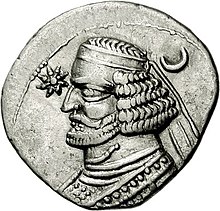| This is a Wikipedia user page. This is not an encyclopedia article or the talk page for an encyclopedia article. If you find this page on any site other than Wikipedia, you are viewing a mirror site. Be aware that the page may be outdated and that the user in whose space this page is located may have no personal affiliation with any site other than Wikipedia. The original page is located at https://en.wikipedia.org/wiki/User:HistoryofIran/Orodes_II. |
| Orodes II | |
|---|---|
| King of kings, Arsaces, Great King | |
 Coin of Orodes II, Mithradatkert mint. | |
| King of the Parthian Empire | |
| Reign | 57–37 BC |
| Predecessor | Mithridates IV |
| Successor | Phraates IV |
| Died | 37 BC |
| Spouse | Laodice |
| Issue | Pacorus I Phraates IV |
| Dynasty | Arsacid dynasty |
| Father | Phraates III |
| Religion | Zoroastrianism |
Orodes II (also spelled Urud II) was King of Kings of the Parthian Empire from 57 to 37 BC.
Background
editOrodes was a son of Phraates III (r. 69–57 BC), whose father Sinatruces (r. 78/7–69 BC),[1] was presumably a son of the Parthian ruler Mithridates I (r. 171–132 BC).[2] The name of the Arsacid branch established by Sinatruces on the Parthian throne has been coined by the modern historian Marek Jan Olbrycht as the "Sinatrucids", which ruled the Parthian Empire from 78/7 BC to 12 AD.[3]
Rise
editIn c. 57 BC Phraates III was murdered by Orodes II and his elder brother Mithridates IV.[4] Mithridates IV, who was the elder brother of Orodes, was at first supported by the latter.[4] However, the two brothers quickly fell out, and Orodes revolted with the support of the Suren clan.[5] They both assumed the title of King of Kings to demonstrate their claims of superiority over each other.[6][a]
This changed the meaning of the title; originally being used as a symbol of political dominance over other realms, the title became known as a symbol of power and legitimacy for contenders in a royal family.[6] Mithridates IV was forced to flee from to Roman Syria. He took refuge with Aulus Gabinius, the Roman proconsul and governor of Syria.[8] Mithridates IV then returned to invade Parthia with Gabinius in support. The Roman proconsul marched with Mithridates IV to the Euphrates, but turned back to restore another ruler, Ptolemy XII Auletes of Egypt, to his throne.[8] Despite losing his Roman support, Mithridates IV advanced into Mesopotamia and managed to conquer Babylonia. He ousted Orodes and briefly restored his reign as king in 55 BC, minting coins in Seleucia until 54 BC.[8]
However, king Mithridates IV was besieged by Orodes' general, Surena, in Seleucia, and after a prolonged resistance, offered battle to Orodes' forces and was defeated.[8] Mithridates IV was afterwards executed in 54 BC by Orodes.[8]
References
edit- ^ Kia 2016, p. 195; Dąbrowa 2012, p. 169
- ^ Olbrycht 2016, p. 23.
- ^ Olbrycht 2016, p. 3.
- ^ a b Kia 2016, p. 196.
- ^ Olbrycht 2016, p. 23; Kia 2016, p. 196; Shayegan 2011, p. 238
- ^ a b Shayegan 2011, p. 238.
- ^ Dąbrowa 2012, p. 169; Kia 2016, p. 23; Shayegan 2011, p. 239
- ^ a b c d e Bivar 1983, p. 49.
Sources
edit- Bivar, A.D.H. (1983), "The Political History of Iran Under the Arsacids", in Yarshater, Ehsan (ed.), Cambridge History of Iran, vol. 3, London & New York: Cambridge University Press, pp. 21–99, ISBN 978-0-521-20092-9.
- Curtis, Vesta Sarkhosh (2007). "Religious iconography on ancient Iranian coins". Journal of Late Antiquity. London: 413–434.
- Curtis, Vesta Sarkhosh (2012). "Parthian coins: Kingship and Divine Glory": 67–83.
{{cite journal}}: Cite journal requires|journal=(help) - Dąbrowa, Edward (2007). "The Parthian Kingship": 123–134.
{{cite journal}}: Cite journal requires|journal=(help) - Dąbrowa, Edward (2010). "Arsakes Epiphanes. Were the Arsacids Deities "Revealed"?": 223–231.
{{cite journal}}: Cite journal requires|journal=(help) - Dąbrowa, Edward (2012). "The Arsacid Empire". In Daryaee, Touraj (ed.). The Oxford Handbook of Iranian History. Oxford University Press. pp. 1–432. ISBN 978-0-19-987575-7.
- Dąbrowa, Edward (2013). "The Parthian Aristocracy: its Social Position and Political Activity": 53–62.
{{cite journal}}: Cite journal requires|journal=(help) - Dąbrowa, Edward (2018). "Arsacid Dynastic Marriages": 73–83.
{{cite journal}}: Cite journal requires|journal=(help) - Garsoian, Nina (2005). "Tigran II". Encyclopaedia Iranica.
- Kia, Mehrdad (2016). The Persian Empire: A Historical Encyclopedia [2 volumes]. ABC-CLIO. ISBN 978-1610693912.
- Marciak, Michał (2017). Sophene, Gordyene, and Adiabene: Three Regna Minora of Northern Mesopotamia Between East and West. BRILL. ISBN 9789004350724.
- Olbrycht, Marek Jan (1997). "Parthian King's tiara - Numismatic evidence and some aspects of Arsacid political ideology". 2: 27–61.
{{cite journal}}: Cite journal requires|journal=(help) - Olbrycht, Marek Jan (2015). "Arsacid Iran and the nomads of Central Asia – Ways of cultural transfer": 333–390.
{{cite journal}}: Cite journal requires|journal=(help) - Olbrycht, Marek Jan (2016). "Dynastic Connections in the Arsacid Empire and the Origins of the House of Sāsān". In Curtis, Vesta Sarkhosh; Pendleton, Elizabeth J.; Alram, Michael; Daryaee, Touraj (eds.). The Parthian and Early Sasanian Empires: Adaptation and Expansion. Oxbow Books. ISBN 9781785702082.
- Rezakhani, Khodadad (2013). "Arsacid, Elymaean, and Persid Coinage". In Potts, Daniel T. (ed.). The Oxford Handbook of Ancient Iran. Oxford University Press. ISBN 978-0199733309.
- Schippmann, K. (1986). "Arsacids ii. The Arsacid dynasty". Encyclopaedia Iranica, Vol. II, Fasc. 5. pp. 525–536.
- Schmitt, Rüdiger (2005). "Personal Names, Iranian iv. Parthian Period". Encyclopaedia Iranica.
- Shayegan, M. Rahim (2011). Arsacids and Sasanians: Political Ideology in Post-Hellenistic and Late Antique Persia. Cambridge University Press. pp. 1–539. ISBN 9780521766418.
Cite error: There are <ref group=lower-alpha> tags or {{efn}} templates on this page, but the references will not show without a {{reflist|group=lower-alpha}} template or {{notelist}} template (see the help page).